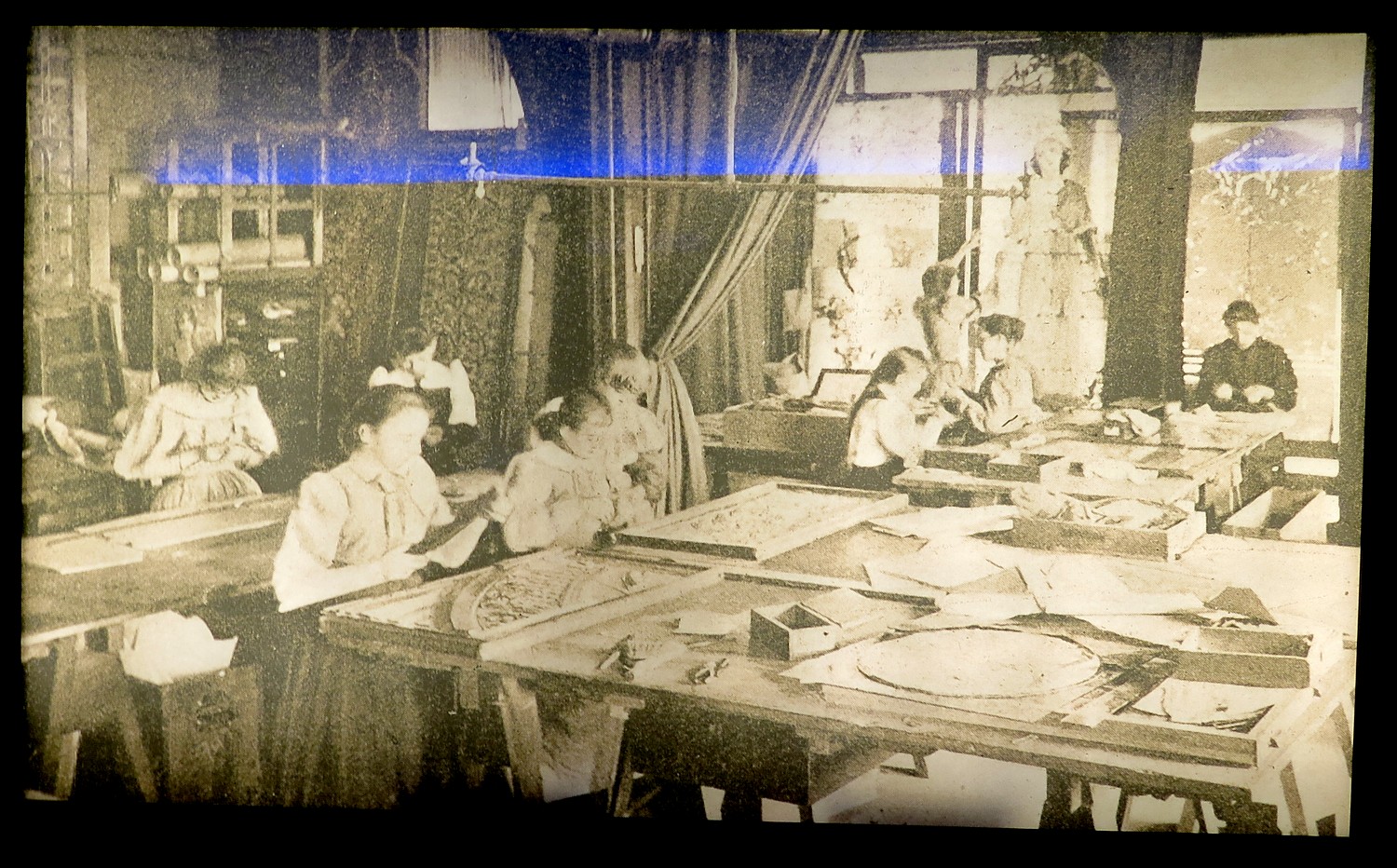
By Karen Rubin, Travel Features Syndicate, goingplacesfarandnear.com
Martin Luther King Jr. and Robert Kennedy are tethered together in peoples’ minds, and not only because they both were assassinated within two months of each other in that fateful year of 1968. A new, remarkable exhibit that has just opened at the New-York Historical Society commemorates the 50th anniversary of those events, examines their conjoined legacy and makes some interesting discoveries: their lives had a kind of parallel trajectory, yet, they consciously steered separate courses, intersecting finally in death.
On view through May 20, 2018, Rebel Spirits: Robert F. Kennedy and Martin Luther King Jr. showcases 61 photographs and 30 documents and artifacts that reveal the relationship between these historic figures. The exhibit is based in part on The Promise and the Dream, written by Vanity Fair contributing editor and New York Times writer David Margolick and produced by Lawrence Schiller for National Geographic Publishers. Schiller, a photojournalist who covered many of the significant events throughout the 1960s, conceived of the project and collected 21,000 photographs, sifting them down to 3,000, then 2,000, and ultimately, over the course of just three days, laid out the photographs that are presented much like a 20-page photo essay in Life Magazine, where Schiller worked, would have produced.
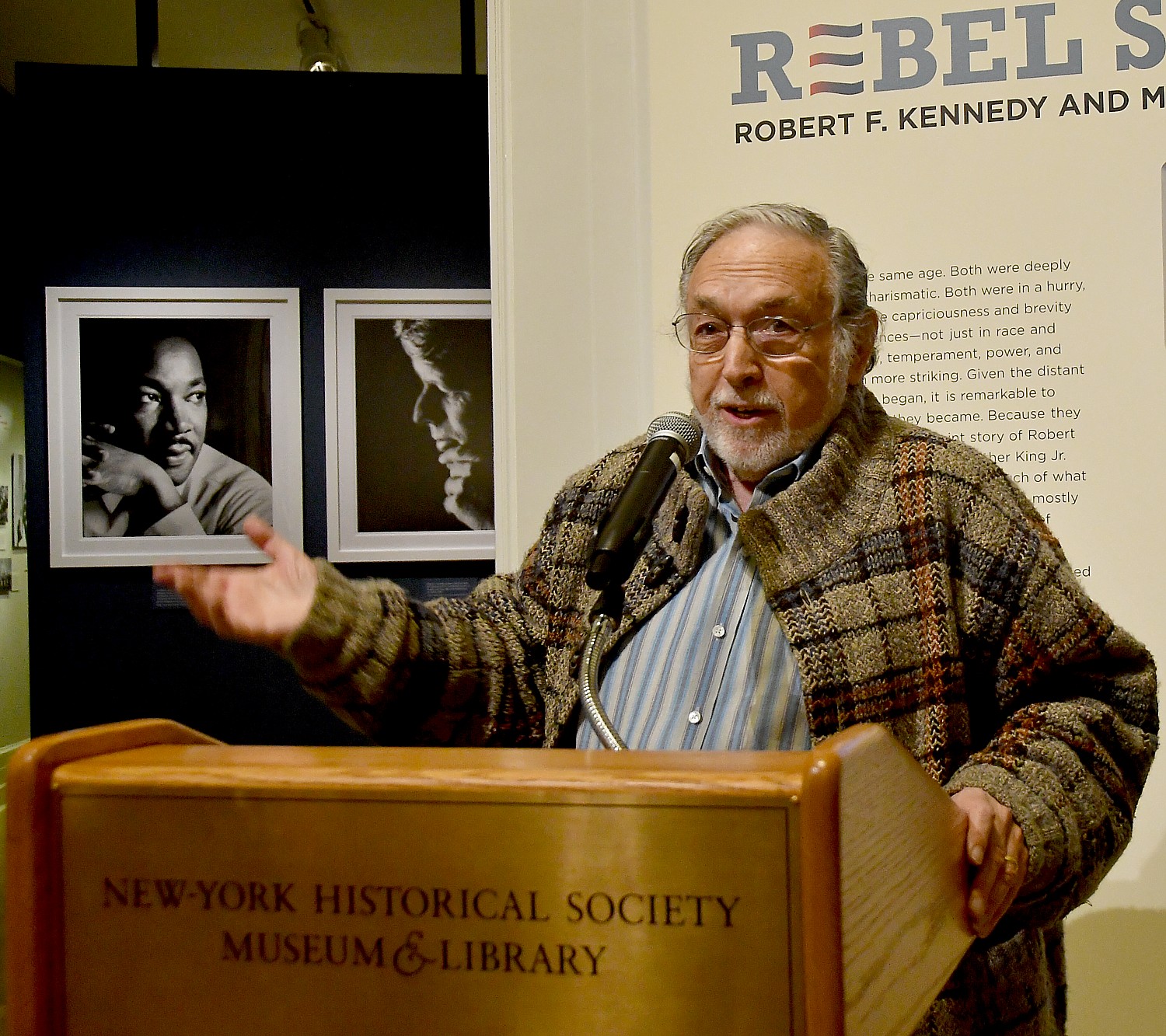
But in the course of gathering that material, an essential question arose: why were there so few photos of King and Kennedy together? The exhibit has just one where the two men were at the same event, with then-Vice President Lyndon Baines Johnson. Another instance where they would have been together was when King testified to a Senate Committee which included Robert Kennedy, in which he stated that the millions of dollars that were being sent to support the war in Vietnam should better be spent to revitalize America’s ghettoes (a photo is taken from behind King). Significantly, while Kennedy supported the idea of spending more in cities, he was forced for political reasons (like the fact that his brother, as President, dramatically escalated America’s role in Vietnam) to disassociate himself from King’s anti-Vietnam stance.
Margolick, who researched and wrote the book in a mere seven months time, started off with no pre-conceived notion, but wanted to come up with some original construct about these two lions of American history.
Indeed, if news is the first draft of history, books provide the room for reflection and context.
The big idea of the book and the exhibit is that “Robert Kennedy was a political person and Martin Luther King Jr. a spiritual person; they respected one another but there was a limit how closely they could ally,” Margolick said at the press opening of the exhibit.
The two men had reason to be wary of one another.
Robert Kennedy was at his core a politician from a political family; on top of that, his brother, as president, had made key decisions including significantly involving the US in war in Vietnam, and was skittish about making civil rights a key focus of his administration; as JFK’s Attorney General, Robert Kennedy had signed off on J. Edgar Hoover’s request to surveil King, whom Hoover was convinced was a Communist. But Kennedy also sent US Marshals to force school integration.
King, for his part, was a spiritual man for whom civil rights was not merely a political issue but a matter of everyday survival for millions of people who could be brutalized without repercussion under a Jim Crow regimen.
“They were initially wary of each other,” Margolick said. “There was an enormous chasm which gradually shrank, but did not entirely disappear.”
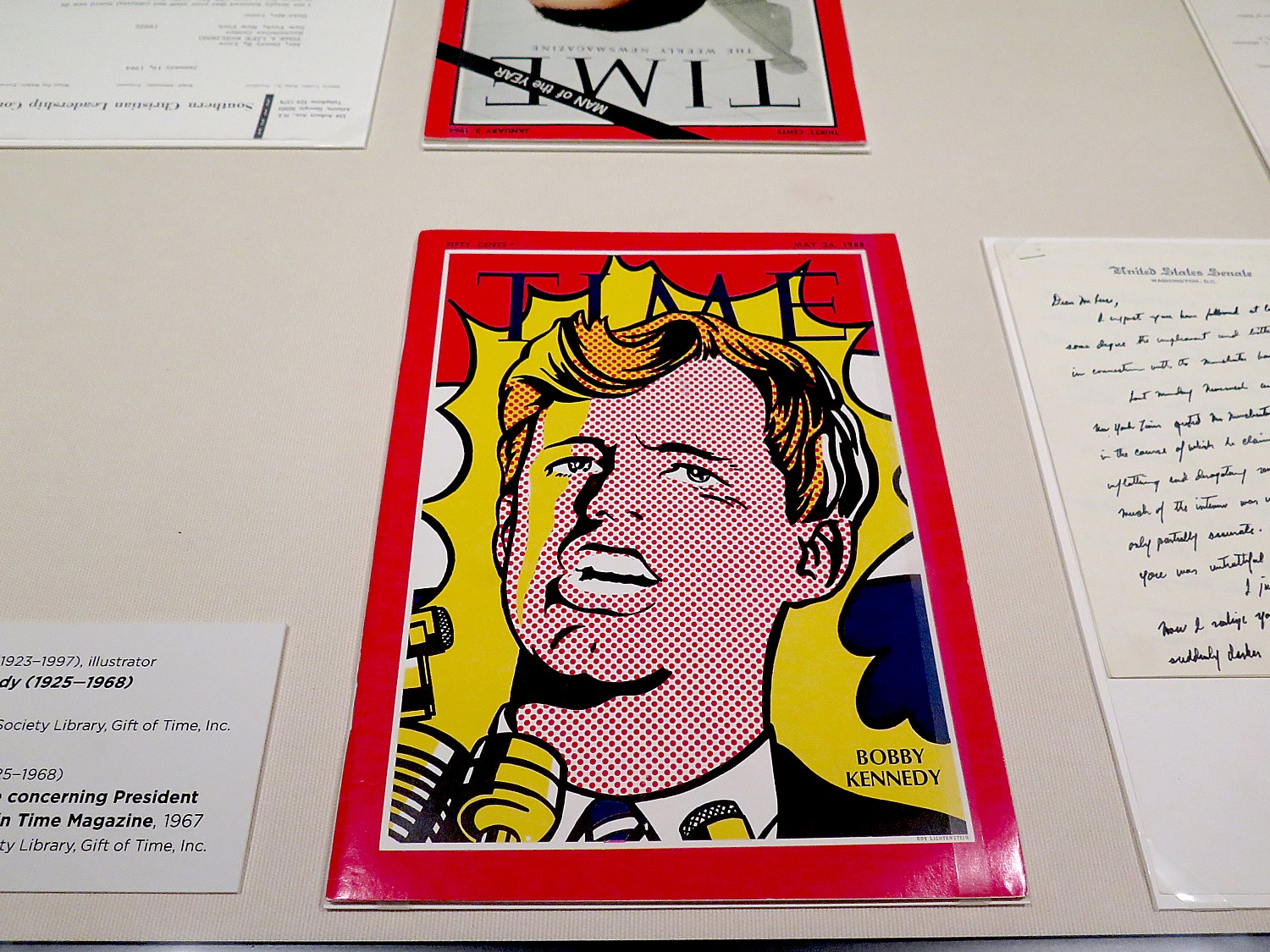
“RFK felt MLK a liability, he couldn’t get close.” There was that special night, when Robert Kennedy, who made a concerted effort to embed himself into black communities when he realized he did not have more than a superficial understanding of issues, was in “black” Indianapolis for a campaign speech and gets notice that King has just been killed, and instead of rushing away, he spoke compassionately to the crowd. “That was a special night. Death was the only time Kennedy actually embraced [the idea] of King. Kennedy was dead two months later. There was no time to carry torch of MLK.
“But even in limited time, Kennedy was reluctant to embrace King. The Kennedys were politicians King was a spiritual man. Kennedy considers the political implications of everything. Part of the purpose of this book is to examine and correct the revisionist idea that were together – really was there was always space between them.”
They also came from completely different worlds: Kennedy chose to take up the fight; the fight chose King.
Over the course of researching the book, Margolick said, “my point of view was constantly evolving. I wanted it to be as original as it could. I looked at newspapers no one had; primary documents not examined before. I came to realize the most precious thing was to talk to dwindling supply of people who knew both men – very few knew both: Andrew Young, William Vanden Heuval and some behind scenes intermediaries.
Margolick realized that an excellent source would be the photographers who photographed both – including Harry Benson, Steve Shapiro – who could even describe how differently they interacted with crowds.
“Both men had a sense of their mortality – they knew they were doomed.” One of the photographers, he thinks it was Harry Benson, said that when King was in a crowd, he would look it over carefully, mindful of his safety. He never stayed in one place longer than he had to.”
But, he adds, “Robert Kennedy didn’t care. He had a premonition of death but approached it differently. He told his security force he didn’t want precautions. There were reporters who never left RFK’s side because they expected he would be assassinated and wanted to be there when it happened.”
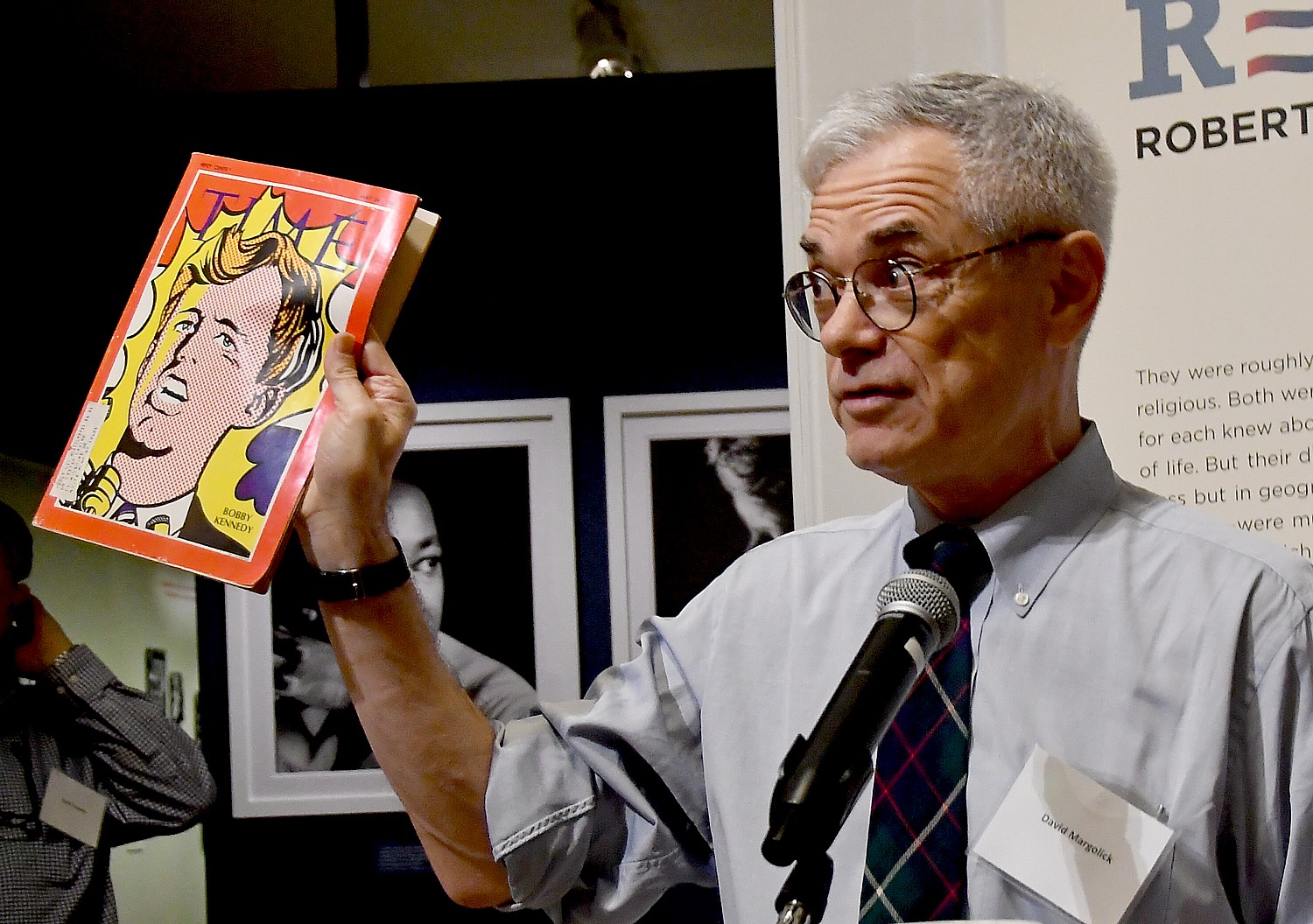
Lawrence Schiller, who organized the project and curated the exhibit, was one of those photographers who helped document history beginning in the 1960s. He was assigned to Robert Kennedy and followed him for the last 40 days of his life. Schiller was at the Ambassador Hotel in Los Angeles the night that Robert Kennedy delivered his last speech, tried to hurry out by going through the kitchen, where he was met by Sirhan Sirhan who shot him dead. (The portrait that opens the exhibit was taken by Schiller on board Kennedy’s plane en route to California just days before the speech.)
He was just 26 years old working as a photojournalist on a fateful day in 1963 when he was summoned from Los Angeles to Dallas after President John F. Kennedy was shot. He was in the police station when, as it happened, the police were booking Lee Harvey Oswald.
“The elevator opened to reveal Oswald, who was only 24 years old. It shocked me that evil could be in such a person – a kid my age had caused this tragedy.”
Schiller, who has several photos in the exhibit, called upon many of the photographers he knew who are represented, but there are many which had not been published before.
The exhibit is laid out chronologically for the most part, but in some cases “emotionally chronologically”, as when a portrait of Robert Kennedy, photographed on Feb. 26, 1962, with a movie slate, is juxtaposed next to a police mug shot of King from Feb. 22, 1956, upon which someone had scrawled “DEAD 4-4-68”; and in a case with artifacts, the Time Magazine editions with each on the cover, is displayed. ”King’s ‘Man of the Year’ drove people crazy,” Schiller remarks.
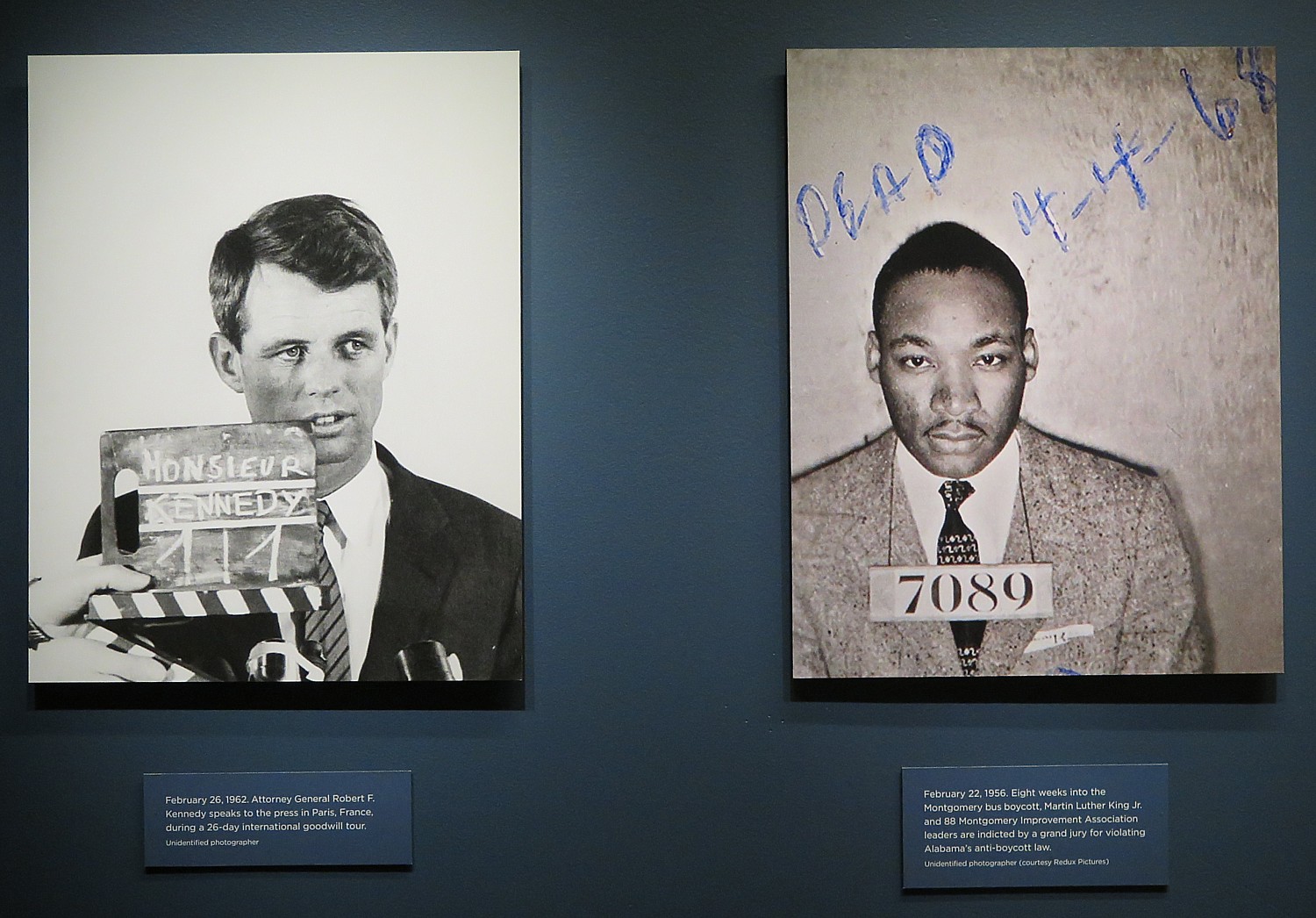
Asked which photo was the most impactful, Schiller points to one of a man with a broom, sweeping the blood from outside King’s hotel room in Memphis, a photo which he said had never been published; another shows the hotel room. Schiller says that people came in and collected vials of blood to keep as a memento.
The exhibit starts with Rosa Parks and ends in a field after Kennedy’s assassination, where people are holding a sign, “So long Bobby.” Several of the photos don’t feature King or Kennedy at all, but provide context: the KKK, US Marshals, Freedom Riders, the march after Medgar Evers was assassinated in June 1963, just five months before JFK was assassinated, in eerie similarity to the one-two King-Kennedy assassinations.
There is great intimacy of the experience – the photos, which were printed all at the same time in the same lab from negatives and then scanned – are 8 x 10 and smaller, the room is compact, so you are close to the images, can easily read the captions and notes.
“The insight we came to early on emerged from the question: Why were there not more photos of the two together?” Margolick said. “The book tries to fill the gap, why there were no more photos of the two together. They kept apart. We are documenting, explaining the absence of something.”
One notable absence is a still photo of Robert F. Kennedy addressing a black audience in Indianapolis the night that King was killed, which in itself, says a lot.
“No one knew how important that speech by Kennedy would be, the night MLK was killed,” Margolick said. “The event that became so important was so scantily covered, there were just two still photographers there from local papers. It was only a 6-7 minute speech, but there is no film of the entire speech.” But it was at that point that Kennedy most fulsomely embraced King. (A portion of the video is displayed.) There’s a monument in Indianapolis commemorating the event.
Born Worlds Apart
Martin Luther King Jr. (January 15, 1929 – April 4, 1968) and Robert F. Kennedy (November 20, 1925 –June 6, 1968) were born worlds apart—culturally, geographically, racially, financially, and politically—but by the time they were killed within months of each another in 1968, their worlds had come together. As their concerns expanded beyond civil rights (King) and organized crime (Kennedy), their ties deepened to encompass shared interests in supporting the poor and opposing the war in Vietnam. This unprecedented exhibition explores the overlapping paths of their lives through images taken by some of the most renowned photojournalists of the era, including Bob Adelman, Danny Lyon, Henri Dauman, Jacques Lowe, Spider Martin, Steve Schapiro, Lawrence Schiller, and Paul Schutzer, alongside original correspondence, publications, and ephemera.
“The year 1968 rocked the nation in many ways, but it would be difficult to point to anything that shocked and sickened Americans more that year than the senseless and tragic deaths of Robert Kennedy and Martin Luther King Jr.,” said Dr. Louise Mirrer, president and CEO of the New-York Historical Society. “Fifty years later, the legacies of Kennedy and King still reverberate. This timely exhibition underscores the two men’s lasting impact on our nation while drawing attention to the ways in which their lives intersected. ”
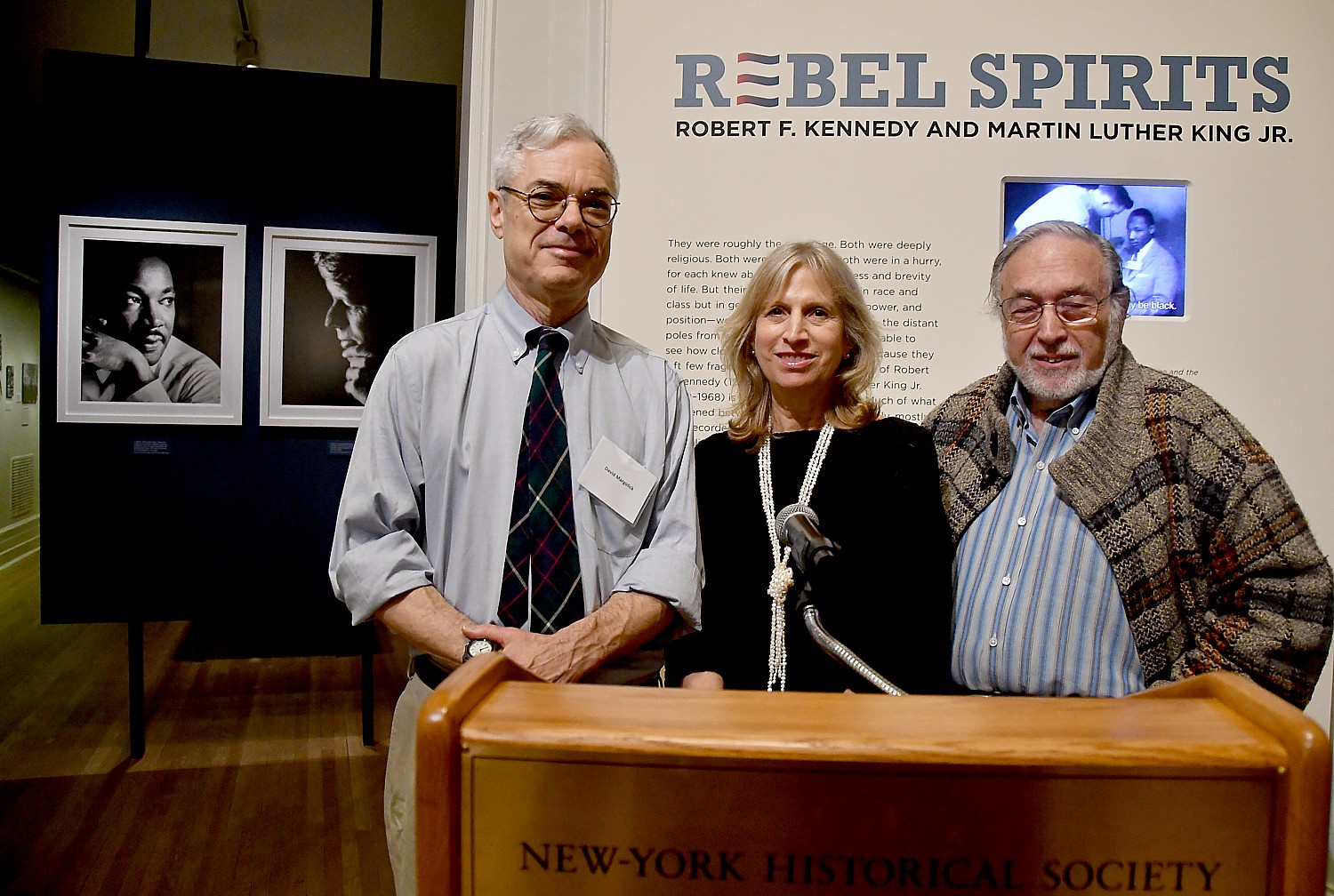
Exhibition highlights include images of King and his son looking at the charred remains of a cross the Ku Klux Klan burned outside his Atlanta home in 1960, King’s mug shot after being indicted for the 1956 Montgomery Bus Boycott, and Kennedy being swarmed by an adoring crowd during his 1968 presidential campaign. Also on view are posters reading “Honor King: End Racism!” and “I Am a Man” that were carried in a Memphis march led by widow Coretta Scott King and her children on April 8, 1968, as well as a black and white “Kennedy/King” button worn by a New Yorker in memory of the two slain leaders.
An adjunct display showcases the bronze sculpture of Martin Luther King Jr.―one of five existing casts created by Harlem Renaissance artist Charles Alston (1907– 1997), on loan from the Community Church of New York.
Rebel Spirits is based in part on The Promise and the Dream, written by David Margolick and produced by Lawrence Schiller for National Geographic Publishers. The exhibition was curated by Lawrence Schiller, Cristian Panaite, and Marilyn Kushner. It was produced by Wiener Schiller Productions, Inc. in association with Susan Bloom International with support from Getty Images, The Jacques Lowe Estate, and Steve Schapiro.
Published by National Geographic and written by David Margolick, The Promise and the Dream: The Interrupted Lives of Robert F. Kennedy and Martin Luther King Jr. features an introduction by historian Douglas Brinkley. The book is available at the NYHistory Store.
Several public programs will provide further insights into the exhibition and its time period. On March 6, eminent legal experts survey the evolution of the U.S. Supreme Court’s interpretations of the 14th Amendment—in commemoration of its 150th anniversary—and civil rights throughout American history, highlighting landmark cases such as Brown v. Board of Education. On April 23, scholar Randall Kennedy discusses the Supreme Court and Martin Luther King Jr. On May 21, journalist Chris Matthews sits down to explore the rebel spirit of Robert Kennedy.
Vietnam War
The New-York Historical Society has a variety of fascinating exhibits, some short term and some ongoing.
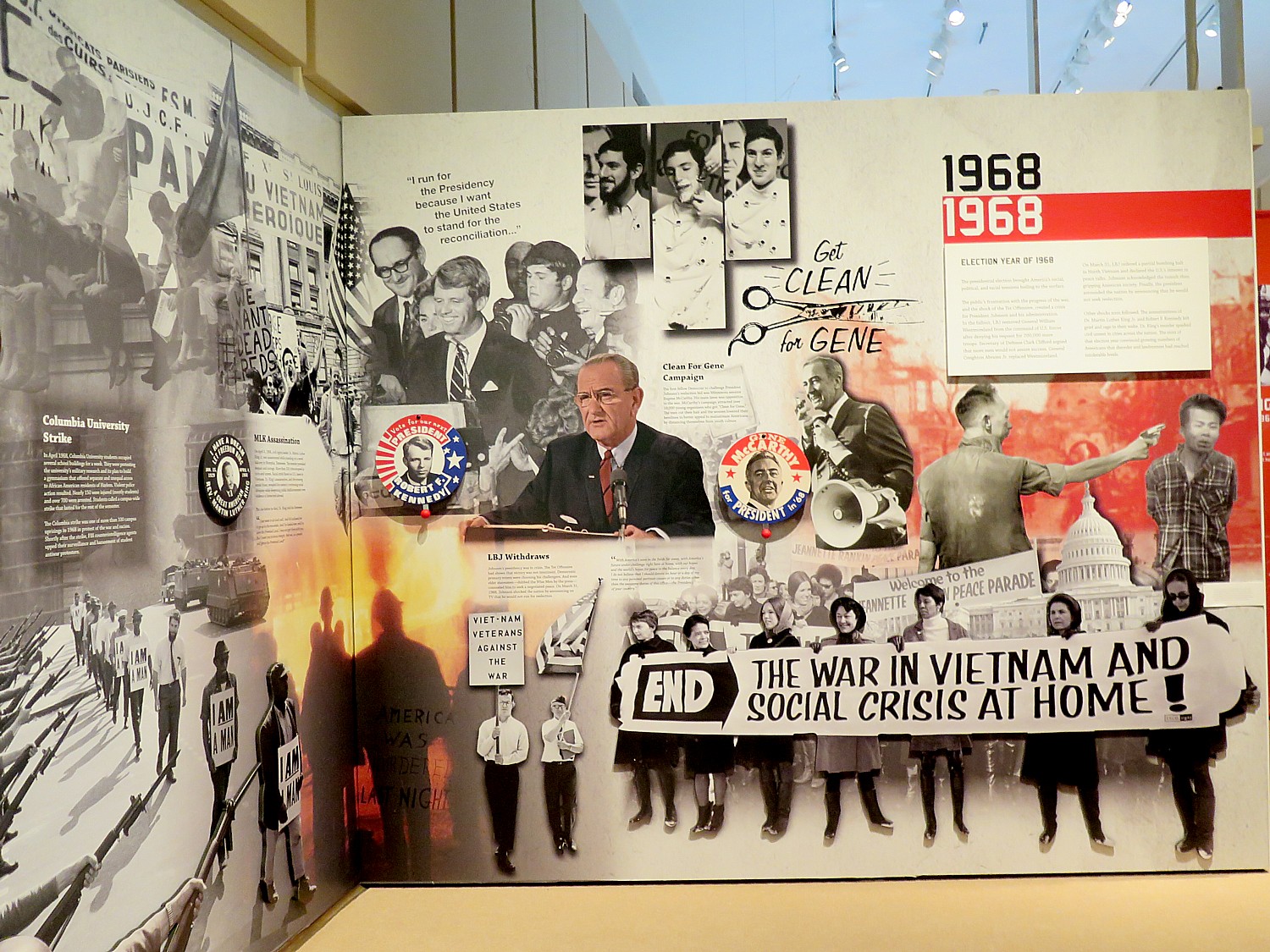
The Vietnam War: 1945 – 1975 on view through April 22, 2018 is particularly timely in conjunction with the “Rebel Spirits.” Featuring interpretive displays, digital media, artwork, artifacts, photographs, and documents, the exhibit provides an enlightening account of the causes, progression, and impact of the war. Spanning the duration of U.S. involvement in Indochina, the narrative incorporates perspectives covering both the home and the war fronts. Displays touch upon the Cold War, the draft, military campaigns initiated by both sides, the growth of the antiwar movement, the role of the president, and the loss of political consensus. The exhibition explores themes of patriotism, duty, and citizenship. Key objects include a troopship berthing unit, interactive murals, vibrant antiwar posters, artwork by Vietnam vets, a Viet Cong bicycle, the Pentagon Papers, and news and film clips.
Gallery of Tiffany Lamps
Step into the Gallery of Tiffany Lamps, a permanent exhibit which is the centerpiece of a newly designed fourth floor, and you are aglow in light and beauty. The exhibit features more than 100 illuminated Tiffany lamps from N-YHS’s spectacular collection displayed within a dramatically lit jewel-like two-story space (the glass staircase is exquisite).

The presentation is breathtaking, and so insightful: it was only in the last decade that it was learned through a series of letters that some of Tiffany’s most famous and prized lamps, featuring nature imagery like wisteria, dragonflies, spider webs, were designed by Clara Driscoll, who headed the Women’s Glass Cutting Department of some 45-55 young women (mainly 16-17 year olds who would work until they went off to be engaged).
It was only in the last decade that it was learned through a series of letters that some of Tiffany’s most famous and prized lamps were designed by Clara Driscoll who headed the Women’s Glass Cutting Department of some 50 young women © Karen Rubin/goingplacesfarandnear.comThe collection comes from Dr. Egon Neustadt. an Austrian immigrant enamored with all things American, who purchased his first Tiffany lamp in 1935 for $12.50 (by then, Tiffany Lamps were no longer in favor, the company closed, Tiffany went bankrupt in 1932 and died in 1933) and went on to amass the largest and most comprehensive Tiffany lamp collection ever assembled. The docent explained that he bequeathed half his collection to the N-YHS and half to the Queens Museum. She points out what would have been the most valuable lamps: the wisteria would have sold for $450; the cobweb for $500, at a time when you could buy a brand new car for that amount. On the mezzanine level, you not only can look down onto the lighted lampshades, but can try your hand at designing your own.
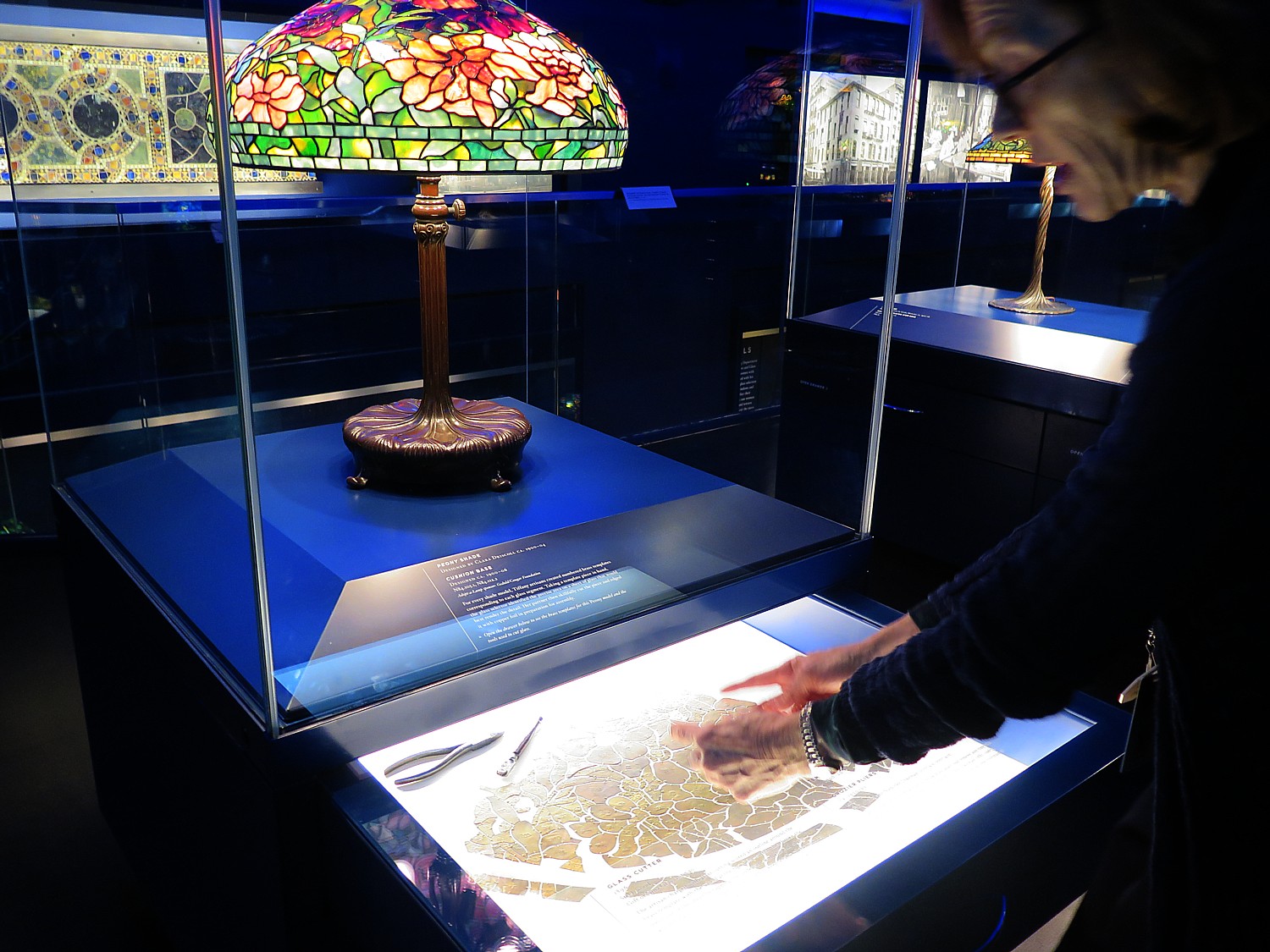
The redesigned fourth floor also offers exhibitions and interactive media that explore American history. Themed displays in the North Gallery present a variety of topics—such as slavery, war, infrastructure, childhood, recreation, and 9/11—offering unexpected and surprising perspectives on collection highlights. Touchscreens and interactive kiosks allow visitors to explore American history and engage with objects like never before. When I visit, a docent is discussing the Industrial Revolution with high school students.
Women’s Rights & Social Activism
A new Center for Women’s History enables visitors to discover hidden connections among exceptional and unknown women who left their mark on New York and the nation with the multimedia digital installation, Women’s Voices, and through rotating exhibitions in the Joyce B. Cowin Women’s History Gallery. Objects from the Billie Jean King Archive are also on view.
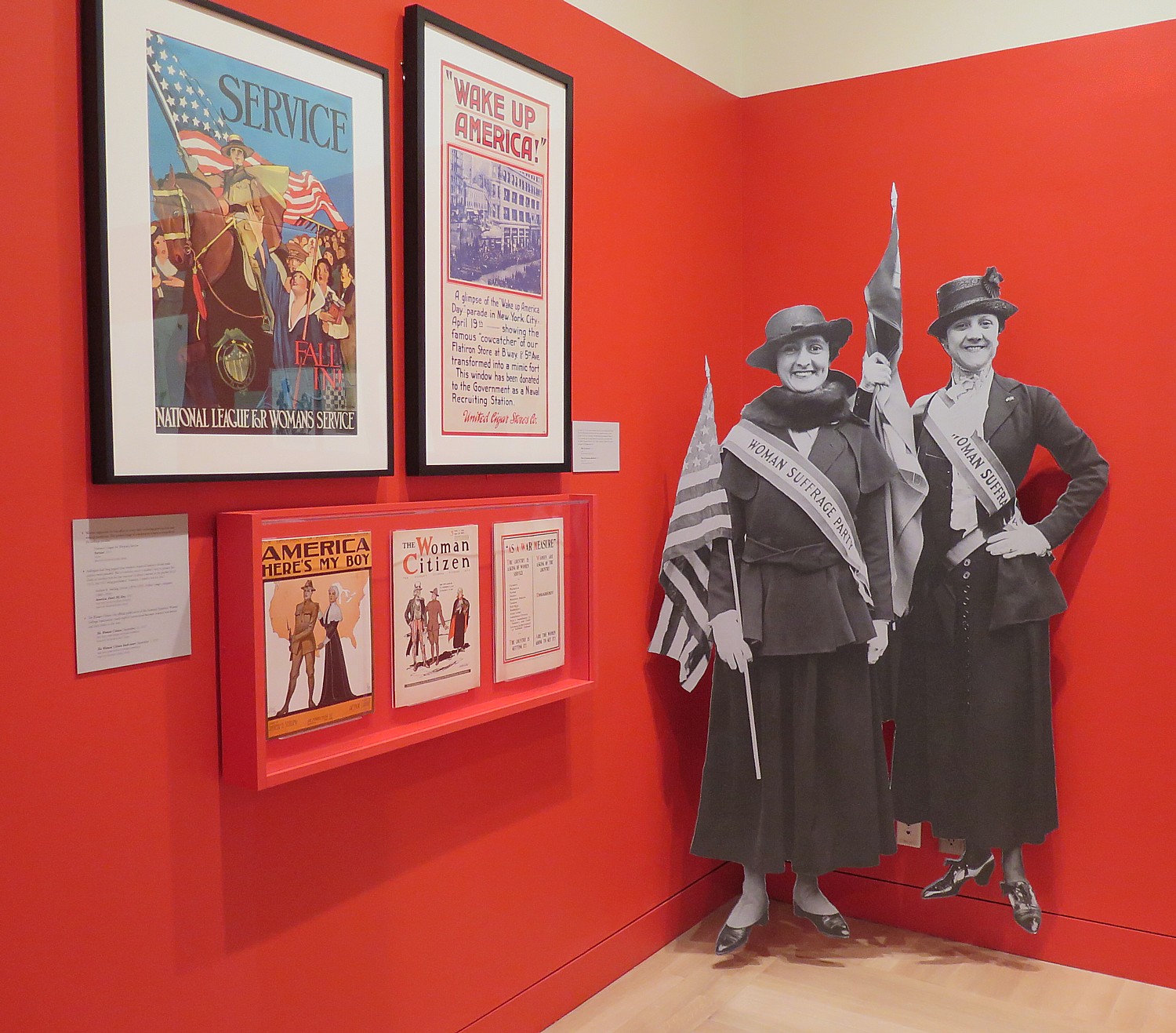
Hotbed, a special exhibit on view through March 25, 2018, is about Greenwich Village in the early 20th century, when it was a hotbed of political activism and social change—where men and women joined forces across the boundaries of class and race to fight for a better world. At the heart of the downtown radicals’ crusade lay women’s rights: to control their own bodies, to do meaningful work, and above all, to vote. Celebrating the centennial of women’s right to vote in New York and on view in the Joyce B. Cowin Women’s History Gallery, Hotbed features immersive installations and more than 100 artifacts and images—drawn from New-York Historical’s archives and several private collections—that bring to life the neighborhood’s bohemian scene and energetic activist spirit.
Collecting the Women’s Marches, on view through June 3, 2018, documents January 21, 2017, when hundreds of thousands rallied at the Women’s March on Washington for diverse issues including women’s rights, racial equality, and the environment. Counting more than 500 sister marches across the United States, it was the largest single-day protest in the nation’s history. As part of its History Responds program, the New-York Historical Society collected a range of artifacts, including signs, sashes, pussyhats, and colorful props, to document the moment. One year later, Collecting the Women’s Marches highlights some of the political and visual themes that emerged, as well as the efforts of individuals and groups that worked behind the scenes. An adjunct display of protest clothing by Olek (Agata Oleksiak), an artist who works in crochet, and Brick x Brick, a public art performance group, is also on view. It is odd to have an exhibit of a major historic event so recent, and to actually have been there.
New York through the Lens of George Kalinsky on view through June 3, 2018 is an amazing photo exhibition of some of New York’s most iconic cultural moments over the past 50 years as captured by George Kalinsky. Serving as Madison Square Garden’s official photographer, Kalinsky has turned truly memorable moments―sporting events, legendary performances, and notable occasions―into lasting images that have defined the city. Among the quintessential photographs on view are Pope John Paul II hoisting a seven-year-old child onto the Popemobile in Madison Square Garden, Bill Bradley celebrating a New York Knicks victory, Sloane Stephens winning the 2017 US Open, and Jesse Orosco falling to his knees on the mound as the Mets won the 1986 World Series.
Collector’s Choice: Highlights from the Permanent Collection, ongoing: Since 1804, the New-York Historical Society has been welcoming to its collection some of the most esteemed artworks of the modern world. Collector’s Choice: Highlights from the Permanent Collection showcases a selection of paintings that reflect the individual tastes of several New York City collectors who donated their holdings to New-York Historical. Joining Picasso’s Le Tricorne ballet curtain are featured American and European masterpieces spanning the 14th through the 21st centuries from Luman Reed, Thomas Jefferson Bryan, and Robert L. Stuart, including colonial portraits of children, marine and maritime subjects, and an installation showcasing recently collected contemporary works.
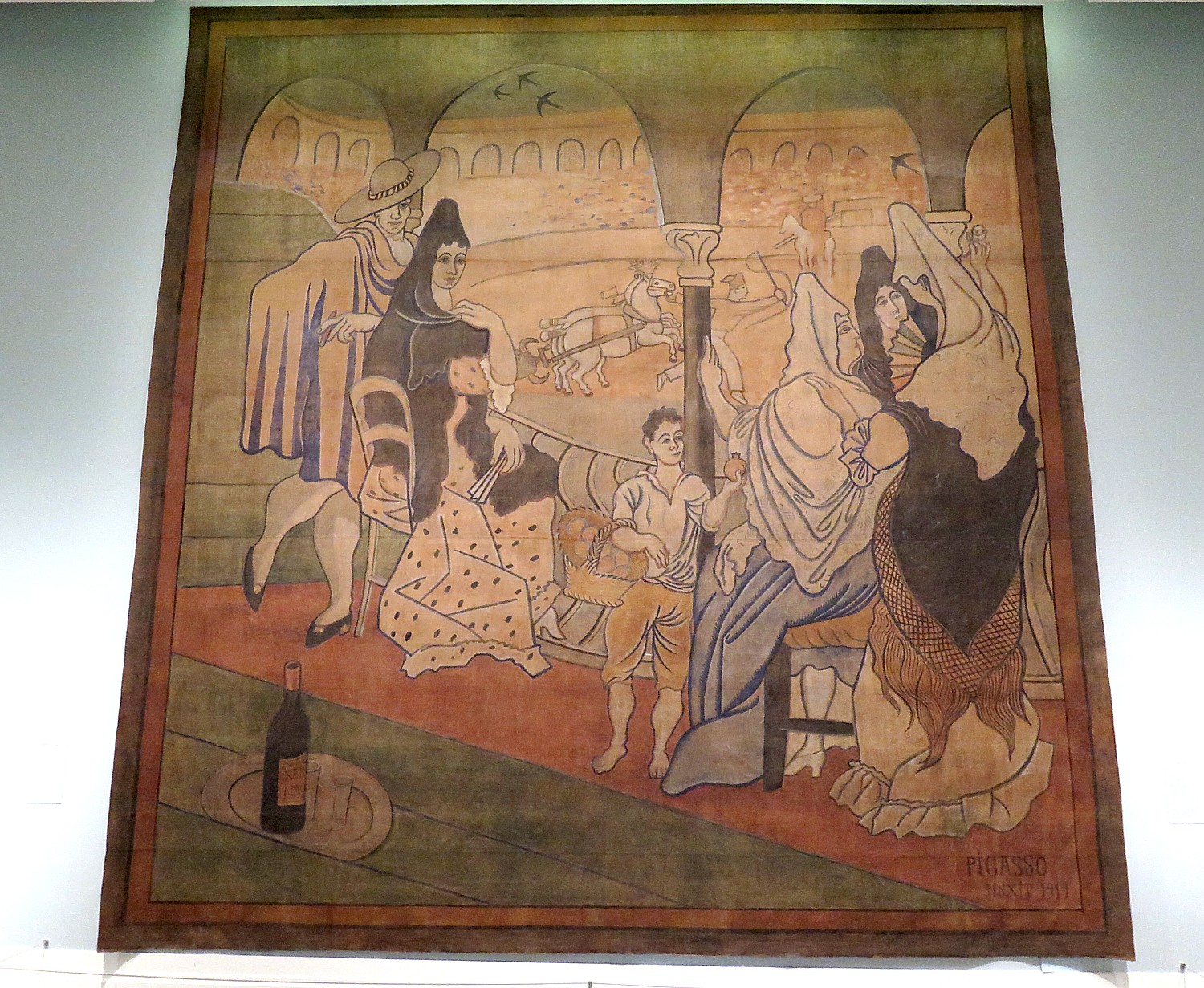
Hours: Tuesday – Thursday: 10 am – 6 pm; Friday: 10 am – 8 pm; Saturday: 10 am – 6 pm; Sunday: 11 am – 5 pm Admission: Adults: $21; Teachers and Seniors: $16; Students: $13; Children (5–13): $6; Children (4 and under): Free. The museum has a pay-as-you-wish policy on Fridays from 6-8 pm.
Check the website for special events and lecture.
New-York Historical Society, 170 Central Park West (at 77th Street), New York, NY 10024, www.nyhistory.org, (212) 873-3400.
_____________________________
© 2018 Travel Features Syndicate, a division of Workstyles, Inc. All rights reserved. Visit goingplacesfarandnear.com, www.huffingtonpost.com/author/karen-rubin , and travelwritersmagazine.com/TravelFeaturesSyndicate/. Blogging at goingplacesnearandfar.wordpress.com and moralcompasstravel.info. Send comments or questions to FamTravLtr@aol.com. Tweet @TravelFeatures. ‘Like’ us at facebook.com/NewsPhotoFeatures
